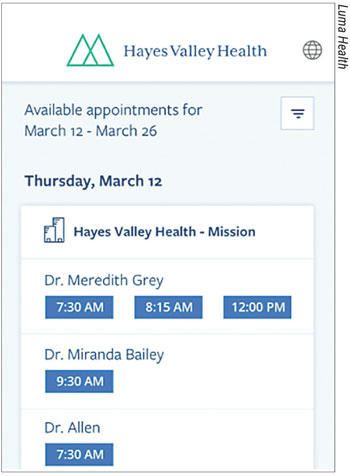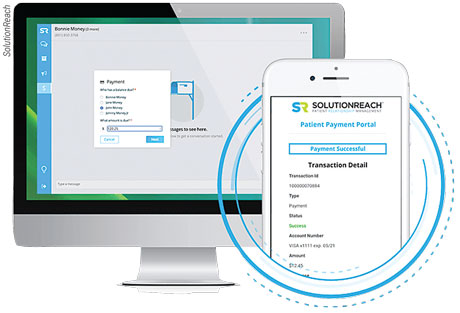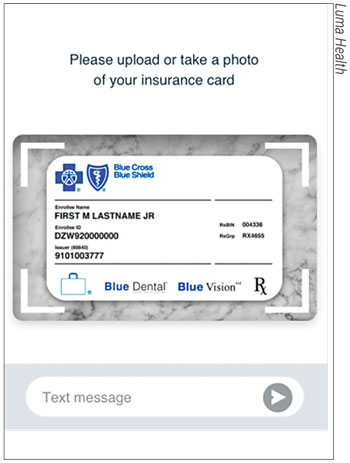Many practices have started reaching for technological solutions such as patient relationship management platforms to accommodate the new care paradigm brought on by the pandemic. These tools can help practices communicate more effectively with patients, minimize cancellations and recoup lost revenue. Here, we’ll take a look at the importance of PRM and see how technological tools can help streamline your practice.
Closing the Gaps
Patient relationship management is the health-care equivalent of customer relationship management in other business settings, say practice management consultants Corinne Wohl, MHSA, COE, of C. Wohl & Associates, and John Pinto of J. Pinto & Associates. “The term is new, but the concept is old,” Ms. Wohl says. “It’s already embedded in your practice at a higher or lower level of competency. Any practice management software that you now use for appointments and billing is, for better or worse, part of your PRM array, as is your website and its embedded patient portal. Ditto for you as the surgeon, and each of your staff members. Taken together, these all result in each patient’s experience as they take an eye-care journey with you, but, along with your electronic health record system, frame your quality and continuity of care.”
Patient recall has only become more difficult in the COVID-19 era. According to Mr. Pinto, this area is one of the most common PRM gaps they see in practices, and one that PRM software is designed to address. “In the average practice we find continuity-of-care gaps that not only degrade patients’ outcomes (and their opinion of the doctor) but impede practice economics,” Mr. Pinto says.
PRM software automates many of the minute tasks of patient-provider communication, freeing up staff members to focus more on direct patient care. But while the software may streamline some administrative tasks, Ms. Wohl and Mr. Pinto say it’s not a magic solution.
“Most gaps in patient care have nothing to do with the PM/EHR/PRM software tools a clinic uses,” Ms. Wohl says. “Most gaps are human ones: poor doctor-patient communication; insufficient attention to detail by staff. Unfortunately, as fees fall and costs rise, these gaps are widening, as doctors and staff alike pedal faster to keep up financially viable volumes—and of course, doing so in the midst of a pandemic just exacerbates the challenge. More than just focusing on software, physician-owners and administrators need to collaborate to continuously improve each patient’s experience.”
There’s a wide array of PRM tools available to choose from. Here’s a brief rundown of five of these tools and some of the features they offer.
Luma Health
According to Luma Health’s COVID-19 data report, the pandemic drove a 108-percent increase in appointment cancellations across its 12-million-patient database between March and April 2020. These cancellations were both patient- and provider-initiated. Many resulted in rescheduled telehealth visits.
 |
Luma Health’s HIPAA-compliant, total patient engagement platform provides interactive patient communication and online scheduling, acquisition and retention tools, appointment reminders, mobile patient intake trackers and a telehealth platform. The company says it’s designed to reduce staff member stress and give patients control over their scheduling. Here are some features Luma Health offers:
• Smart waitlist. This feature automatically offers canceled appointment slots to the next patient waiting for that specific appointment type, provider and location.
• Referral capture and conversion. Automated text messages prompt referred patients to schedule appointments.
• Patient recall. This tool automatically contacts existing patients and prompts them to schedule recommended follow-up appointments.
• Multilingual messaging. Luma Health offers more than 20 languages for patient engagement.
• Mobile patient intake. This feature allows for contactless check-in and collection of patient data. Patients can upload photos of insurance cards and driver’s licenses, fill out COVID-19 screening forms and “wait in line” with a virtual waiting room.
• User-friendly telehealth. There’s no need for patients to download apps or create portal accounts for their telehealth visit. Patients can also invite up to two additional guests to help them during their virtual appointment.
Luma Health is compatible with more than 70 EHRs and PM systems, such as Epic, Centricity, Allscripts, NextGen, eClinicalWorks and more. The platform also provides data analytics for tracking communication effectiveness, patient engagement and patient satisfaction. For information or to request a custom demo, visit lumahealth.io.
SolutionReach
SolutionReach is an all-in-one patient relationship management tool that can help you grow your practice and meet the needs of the new normal, the company says. Its platform is designed to help health-care providers deliver better care and increase revenue by strengthening patient relationships. Here are some of its features:
• Newsletter templates. SolutionReach provides newsletter templates that can be customized and personalized for patients. The company says these are powerful patient education tools, since many patients forget what their providers tell them. The company suggests using the newsletters for conveying disease information, noting the importance of taking medications as prescribed or communicating office events such as closures or COVID-19 protocol updates.
• Cost-saving tools for patients. This platform helps patients adhere to their insurance plans and choose the most appropriate, in-network options.
 |
• Contactless check-ins. SolutionReach’s digital approach to patient engagement minimizes risk with non-contact patient tools, the company says.
• Marketing support. SolutionReach provides marketing tools to make email campaigns easy, says the company. With this tool, users can create individual messages or a series of messages, also known as “drip campaigns,” to reach patients and inform them of important events or changes.
• ASAP wait list. Patients often complain about wait times not only in the office, but for appointments as well. This tool automatically sends messages to patients, notifying them of an opening in the schedule.
• Recall reminders. The company notes that it’s much easier to bring existing patients back than it is to get new patients. This tool offers flexible, customizable reminders for automatic patient messaging. SolutionReach says it keeps practice schedules full and effectively brings back patients for follow-up care.
For more information or to schedule a demo, visit solutionreach.com.
My Patient Messages
My Patient Messages’ cloud-based platform provides automated patient relationship and practice management support. The company says its platform improves the scheduling and appointment-reminder experience and encourages patient-practice engagement. Features include:
 |
• Appointment notifications. My Patient Messages notes that patients expect to receive immediate confirmation of appointment bookings and may become anxious with delays. This tool sends texts or emails shortly after the booking. Additionally, it provides a series of notifications using the patient’s preferred contact method. Reminders are sent a week prior to the appointment, then two days before the visit and then finally on the day of the appointment. Practices can also create custom cancellation messages if circumstances change.
• Appointment generation. The platform offers patients online scheduling through email newsletters or social media pages. It also notifies patients to schedule follow-up appointments, identifies those who are overdue for an appointment and automatically prompts no-shows to reschedule.
• Practice marketing tools. This feature surveys your patients to identify those who are most likely to write positive public reviews and then directs them to well-known review sites such as Health Grades, Yelp, Google and Facebook. It also surveys patient experience and generates survey data and summary reports, with charts and graphs. My Patient Messages provides patient educational content through email broadcasts; on-hold messages, where you can also include office policies; and with ready-to-use social media posts and newsletter templates with vetted content from accredited organizations.
• Practice management tools. This tool flags scheduling gaps, high-probability no-shows and appointment requests. A waitlist management tool detects cancellations and fills vacancies. Additionally, My Patient Messages stores and manages patient data and records in one place, says the company. It also automatically collects and updates patient information.
My Patient Messages has three pricing plans: basic; professional; and enterprise. For information or to request a quote, visit mypatientmessages.com.
Inphonite
Inphonite is a streamlined automated appointment reminder tool. The company says it’s fully customizable and saves practices time and money by automatically connecting with clients. Highlights include:
• Texting. This feature enables you to send SMS texts from your business number. The company says this helps clients recognize who’s texting them.
• Surveys. Inphonite says their patient experience surveys help to improve client satisfaction and retention. Patients are automatically prompted to respond after their appointment.
• Appointment reminders. The platform sends automated voice, email and text reminders. This helps to reduce no-shows, the company says.
• Group notifications. With this feature, practices can quickly send updates to large groups of people about inclement weather, closings or emergencies.
• Privacy. Inphonite provides private messaging for sending portal information such as lab results or private messages from the doctor.
The mobile version features an interface that the company says is easy-to-use and includes instant messaging. It also allows users to view appointments and review reports. It’s available for both Android and iOS. For information or to request a demo, visit inphonite.com.
NexHealth
NexHealth is a patient management and telehealth tool that includes messaging, appointment and recall reminders, email and texting campaigns, waitlists, reports and online booking. Other tools include:
• Telehealth. NexHealth’s HIPAA-compliant platform is safe and secure, the company says. No log-ins or downloads are required and practices can integrate appointments with their PM software. It also includes a cloud-based waiting room. Patients receive a link that takes them to the virtual exam room.
• Payments. NexHealth says it makes it easy for patients to pay with text and email-based billing—no log-ins or passwords required. The platform also automatically sends patients payment statements and sends confirmation emails once payment has been received. Payments are automatically deposited into your bank account. NexHealth says that 80 percent of patients on their platform pay within 10 business days.
• Digital forms. This feature eliminates paperwork and security risks, the company says. It provides custom digital patient forms to collect information, including medical history, authorization and consent forms.
• Developer tools. NexHealth is compatible with a number of EHRs. The company says integration is seamless with their single-application programming interface, and says the API reduces production costs and cuts down on development time by reducing high-value tasks and bypassing manual EHR integration.
NexHealth has four pricing plans tailored to practices’ specific needs: acquire; activate; retain; and complete. For information or to see a demo, visit nexhealth.com. REVIEW



